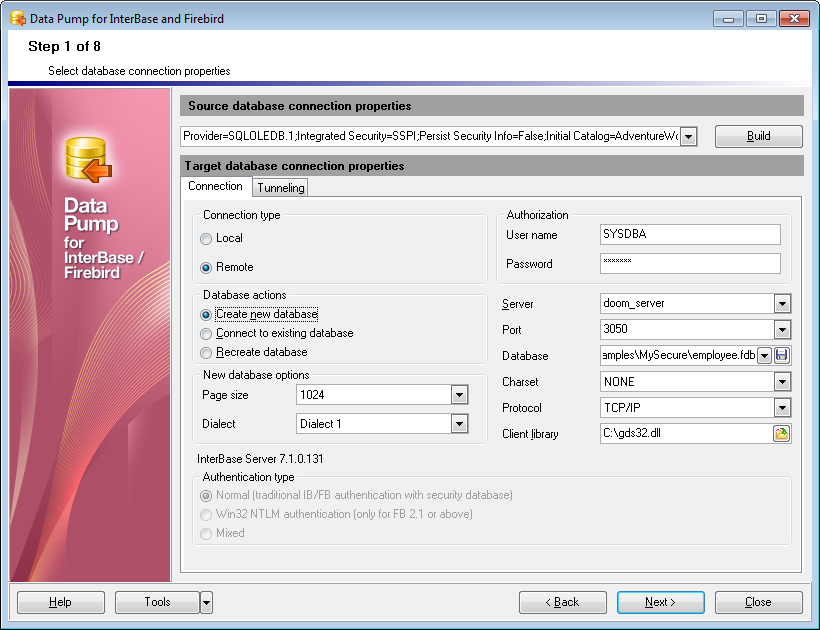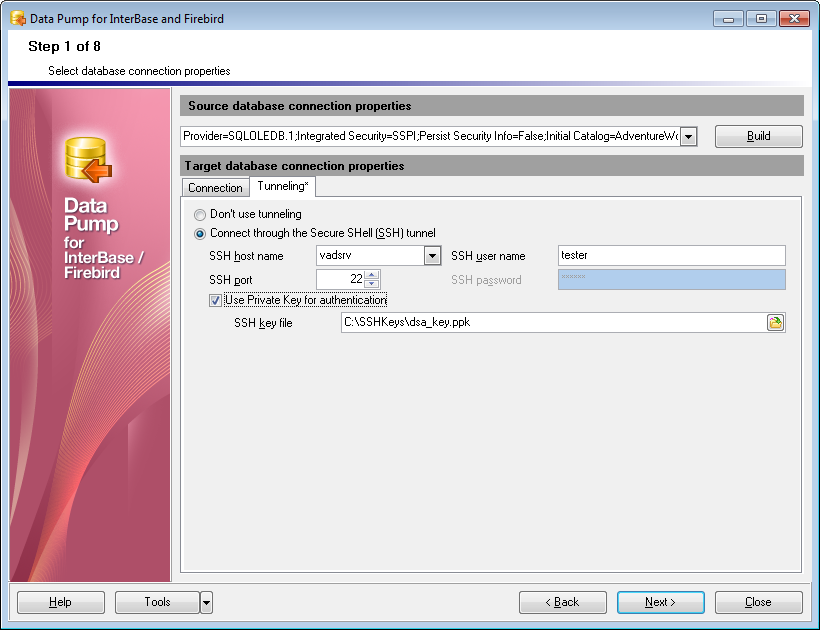Online Documentation for Data Pump for InterBase/Firebird
Step 1 - Setting connection properties
At Step 1 of the wizard you should set the source and the target database connection properties.
Please note that you need to have sufficient privileges to be able to write to the destination database on Interbase/Firebird server.
Note: To establish connection to the source database, it is necessary to use additional software, namely data sources (OLE DB Providers and ODBC Drivers) which are distributed by DBMS developing companies and third-party developers. EMS Data Pump processes information received from the data source. The utility itself extracts neither data nor metadata from the source database. Therefore the functionality of Data Pump may be partially limited by the abilities of data source being used.
Source database connection properties
In order to set the source database connection properties, use Data Link Properties builder or select an initialization string from the list of previously built ones. To call the Data Link Properties dialog, press the Build button.

Target database connection properties
First select the connection type: ![]() local or
local or ![]() remote.
remote.
Local connection is used to connect to Interbase/Firebird server running on the same machine where Data Pump for Interbase/Firebird is launched.
The Remote mode allows you to connect to Interbase/Firebird server running on another computer in the network.
Database actions
You can also set the preferable database action:
![]() Create new database
Create new database
Select this action to create a new database on the target Interbase/Firebird instance to pump data into this database.
![]() Connect to existing database
Connect to existing database
Select this action if the target database for pumping data already exists.
![]() Recreate database
Recreate database
If this action is selected, the target database will be dropped and then recreated (NB: you will lose all data previously stored in the specified database in this case).
New database options
This group of options is available if you have chosen to create a new database or recreate an existing one. Here you can specify the page size (1024, 2048, 4096, or 8092) and the dialect (Dialect 1 or Dialect 3) for the newly created/recreated database.
Authorization
Here you must specify valid authorization info to access the target Interbase/Firebird server: User name and Password.
The default superuser name is 'SYSDBA' with password 'masterkey'.
Server
For remote connection you should enter Interbase/Firebird host name in this field, or select one from the drop-down list.
Port
Use this field to specify a port to connect through.
You also need to specify the path to the Client library and the path to the Database file (*.gdb for InterBase or *.fdb for Firebird) in the corresponding fields. For successful connection to the server it is crucial to use the appropriate client library - the one that is compatible with the server you are using: gds32.dll for Interbase and fbclient.dll for Firebird. Please note that the client library file must be located on your local machine (e.g. in the directory where the utility is installed). Bear in mind that the path to the database file should be set relatively to the Interbase/Firebird server file system.
For remote connection you should also specify the preferable Network protocol (TCP/IP, NetBEUI, Novell SPX).
If necessary, use the drop-down list to specify the preferable Charset to be used by the application.
Authentication type
This group is only available in case you connect to Firebird 2.1. Specify the preferable type of server authentication to be used for the connection:
![]() Normal
Normal
![]() Win32 NTLM authentication
Win32 NTLM authentication
![]() Mixed
Mixed
If you are using the EMS SQL Management Studio for Interbase/Firebird version of Data Pump for Interbase/Firebird then the Select registered database button is available. Click this button to pick a database already registered in the EMS SQL Management Studio in the Select Host or Database dialog.
Tunneling settings
To setup the connection via SSH tunnel, input the following values in the corresponding fields:
- SSH host name is the name of the host where SSH server is running
- SSH port indicates the port where SSH server is activated
- SSH user name stands for the user on the machine where SSH server is running (Note: it is a Linux/Windows user, not a user of Interbase/Firebird server)
- SSH password is the Linux/Windows user password
For details see SSH tunneling options.

When you are done, click the Next button to proceed to the selecting source schemas step of the wizard.



































































